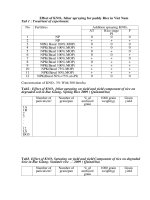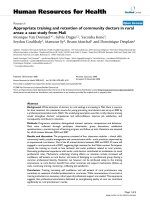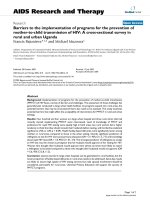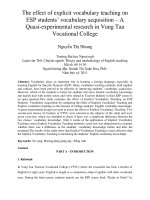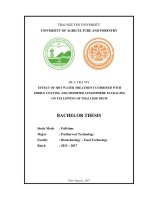Effect of profenofos on Rohu fish (Labio rohita): A fish widely cultivated in rural areas of India
Bạn đang xem bản rút gọn của tài liệu. Xem và tải ngay bản đầy đủ của tài liệu tại đây (133.76 KB, 5 trang )
Int.J.Curr.Microbiol.App.Sci (2017) 6(5): 1889-1893
International Journal of Current Microbiology and Applied Sciences
ISSN: 2319-7706 Volume 6 Number 5 (2017) pp. 1889-1893
Journal homepage:
Original Research Article
/>
Effect of Profenofos on Rohu Fish (Labio rohita): A Fish Widely
Cultivated In Rural Areas of India
Sadhna Kesharwani1, K.K. Dube2 and Rizwana Khan1*
1
Department of Zoology and Biotechnology, Govt. M.H. College of Home Science and Science
for Women, Jabalpur 482001 MP, India
2
Emeritus Professor, Government Autonomous Science College, Jabalpur 482001 MP, India
*Corresponding author
ABSTRACT
Keywords
Labio rohita,
Profenofos,
aquatic ecology,
LD50,
Hematology.
Article Info
Accepted:
19 April 2017
Available Online:
10 May 2017
The rohu, Labio rohita, is an important freshwater fish. The rohu occurs
throughout in South Asia and is an important aquaculture freshwater species.
Rohu is one of the major carp, being cultivated in small aquatic water bodies as
well as in artificial tanks in rural parts of Jabalpur. On the other hand, profenofos,
an organophosphate insecticide, is being used on a variety of crops including
wheat, cotton, maize, potato, soybean, and sugar beet. It is primarily used against
lepidopteran insects as well as against wheat and cabbage aphids. Extensive use of
this pesticide has increased its content in the soil and also in aquatic bodies in rural
areas of India. The present study is focused on lethal effects of profenofos on rohu
fish, being cultivated in and around Jabalpur and changes thereof in the fish
hematology. The in vitro study will come up with knowledge of toxic values of the
pesticide and will help the fish cultivators of the rural area of Jabalpur.
Introduction
Fisheries in India are a very important
economic activity and a flourishing sector
with varied resources and potentials. Only
after the Indian Independence, has fisheries
together with agriculture been recognized as
an important sector. The vibrancy of the
sector can be visualized by the 11–fold
increase that India achieved in fish production
in just six decades. As the second largest
country in aquaculture production, the share
of inland fisheries and aquaculture has gone
up from 46 percent in the 1980s to over 85
percent in recent years in total fish
production. Freshwater aquaculture showed
an overwhelming ten-fold growth from 0.37
million tonnes in 1980 to 4.03 million tonnes
in 2010; with a mean annual growth rate of
over 6 percent. Freshwater aquaculture
contributes to over 95 percent of the total
aquaculture production. The freshwater
aquaculture comprises of the culture of carp
fishes, culture of catfishes, freshwater prawns,
pangasius, and tilapia. Thus, the production of
carp in freshwater from the bulk of major
areas of aquaculture activity. The three Indian
major carps, namely catla (Catla catla), rohu
(Labeo rohita) and mrigal (Cirrhinus
mrigala) contribute the bulk of production to
the extent of 70 to 75 percent of the total fresh
water fish production (Ayyappan, 2014).
1889
Int.J.Curr.Microbiol.App.Sci (2017) 6(5): 1889-1893
In rural areas, the carp culture is mainly done
in natural ponds as well as in artificial ponds
made in the agricultural fields. Intensive uses
of pesticides and insecticides in agriculture
has shown its side effects as the agricultural
runoff or the water from the fields, that drains
into the water bodies or aquaculture ponds is
polluting the water with excessive amounts of
pesticides and insecticides. The higher levels
of such pollutants make the water unsuitable
for aquaculture as well as for other
recreational purposes (Dunier and Siwicki,
1993). Profenofos is an organophosphate
insecticide, largely used against Cotton
MealyBug, cabbage caterpillar, Plutella
xylostella and asparagus caterpillars, as well
as against wheat and cabbage aphids (US
EPA, 2015). Like other organophosphates, the
profenofos mechanism of action is via the
inhibition of the acetyl cholinesterase
enzyme.
The organophosphate insecticides have been
shown to exert lethal effects on some species
of fishes and other aquatic fauna (Bacchetta et
al., 2014). Since rohu is one of the major carp
and economical backbone of the aquaculture
industry in India, the present paper is oriented
towards studying the lethal effects of
propenofos on vital organs of the rohu fish
(Labio rohita) in laboratory conditions in
order to understand the deleterious effects of
the propenofos.
Materials and Methods
Collection and preparation of experimental
fishes
with 0.01% potassium permanganate solution
to obviate dermal infections. The fishes were
fed with commercially available fish food and
acclematized for 15 days before starting the
experiment.
Exposure to profenofos
For the experiments on exposure of
profenofos, the method of Jhingran (2007)
was adopted. Profenofos 98% [O-(4-Bromo2-chlorophenyl)
O-ethyl
S-propyl
phosphorothioate] was purchased from the
local market, manufactured by Excel Crop
Care Ltd, Mumbai. The fishes were divided
into groups, having 10 fishes in each group.
The first group served as a control and
received no insecticide. The other groups
received
different
concentrations
of
propenofos. The fingerlings of Labeo rohita
were exposed to the 6 concentrations of
profenofos i.e., 0.2, 0.4, 0.6, 0.8, 1.0 and 1.2
µg L-1 (Ghazala et al., 2016, Singh and Alam,
2016). Fish were fed daily with commercial
diet at the rate of 3 % of their body weight in
two fractions at an interval of 8 hours. The
fish blood was collected at 96 hours for the
haematological experiments.
Haematological tests
The fish collected every 24 hours was
immediately processed for the determination
of vital haematological parameters such as
haemoglobin (Hb), RBC count, WBC count
and haemtocrit (Hct) using standard
haematological procedures.
Determination of LC50 values
The test fishes (L. rohita) were collected from
local aquaculture pond in the city of Jabalpur
(India). Living and healthy Labio rohita of
body size of 10 ± 1 cm and body weight of 30
± 2 g were chosen for the study. The fishes
were kept in glass aquaria containing 25 L of
ground water, with continuous aeration
through aquaria pumps. Fishes were treated
The 96 hour 50% lethal concentration (LC50)
was calculated using log of the concentration
verses mortality rate at different time intervals
and fitting a non-linear regression curve using
Sigma Graphpad Prism® software, version
6.0.
1890
Int.J.Curr.Microbiol.App.Sci (2017) 6(5): 1889-1893
Results and Discussion
The in vitro experiments for exposure of
Labio rohita with different concentrations of
profenofos showed higher mortality rates after
96 hours in higher concentrations. The LC50
values obtained by fitting a non-linear
regression dose response curve (Fig 1) was
found to be 0.62 µg L-1 with a range of 0.58
to 0.67 µg L-1 (Table 1).
The haematological parameters were tested
for the fishes survived 72 hours or more under
influence of various dosages of profenofos. At
least 3 fishes were used for the
haematological analysis using standard
methods. Table 2 shows that the haemoglobin
percentage decreased from 10.2 ± 1.10 to 7.9±
0.56. The dosage of 0.4 µg L-1 and higher
showed
significant
differences
in
haemoglobin concentration in test fishes.
Similar effects were shown by RBC count as
well as haematocrit (packed cell volume). The
RBC count reduced from 3.41 ± 0.56 to 2.01
± 0.31 x 106 cells µl-1 while haematocrit was
reduced to 27.6 ± 1.10 to 22.1 ±0.31 %. The
WBC count was also affected by increasing
concentrations of profenofos. The WBC count
increased from 4.73 ± 0.32 to 6.24 ± 0.61 x
103 cells µl-1. Again, the profenofos
concentration higher than 0.4 µg l-1 produced
significant increases in WBC count as shown
by one way ANOVA test in comparison to
control.
Table.1 Analysis of LC50 values of profenofos on Labio rohita under in vitro conditions
S.No.
1.
2.
3.
4.
5.
6.
7.
Particulars
LogLC50
Slope
LC50
Upper limit
Lower limit
Degrees of Freedom
R square
Values
-0.2049
2.445
0.62
0.6747
0.5768
19
0.9561
Table.2 Haematological parameters of Labio rohita exposed to different concentrations of
profenofos under in vitro conditions. The data are presented as mean ± standard deviation (n=3).
The values marked with asterisk are significantly different from control using one way ANOVA
(p>0.05)
Concentration of
profenofos
(µg L-1)
(Control)
0.2
0.4
0.6
0.8
1
1.2
Haematological parameters (mean ± SD)
Haemoglobin
RBC count
Haematocrit
WBC Count
6
-1
(%)
(x10 cells µl )
(%)
(x103 cells µl-1)
10.2 ± 1.10
3.41 ± 0.56
27.6 ± 1.10
4.73 ± 0.32
10.1 ± 0.82
3.20 ± 0.67
26.7 ± 0.98
4.81 ± 0.34
9.6 ± 0.75*
3.05 ± 0.23*
25.9 ± 0.76*
4.90 ± 0.29*
9.2 ± 1.02*
2.82 ± 0.34*
25.8 ± 0.67*
5.21 ± 0.39*
8.7 ± 0.92*
2.39 ± 0.39*
24.8 ± 0.52*
5.34 ± 0.54*
8.1 ± 0.45*
2.34 ± 0.29*
23.7 ± 0.43*
5.78 ± 0.67*
7.9 ± 0.56*
2.01 ± 0.31*
22.1 ± 0.31*
6.24 ± 0.61*
1891
Int.J.Curr.Microbiol.App.Sci (2017) 6(5): 1889-1893
Fig.1 Dose response curve showing mortality rate of Labio rohita against various doses of
profenofos under in vitro conditions
lo g -d o s e v s r e s p o n s e
150
100
50
-1 5
-1 0
-5
0
5
lo g [ A g o n is t ] , M
The organophosphates, i.e. profenofos are
modern synthetic insecticide and are potent
neurotoxic molecules (Lundbaye et al., 1997).
The environmental risk assessment of any given
pesticide/insecticide depends on its toxicity to
the fish and other organisms. Profenofos is one
of the organophosphates that are widely used in
India for the agricultural purposes. The 50%
lethal concentration (LC50) is the parameter
that shows the toxicity and is considered to be
the preliminary step for studies into the extent
of acute or chronic toxicity. Our results showed
a 96 hour LC50 value of 0.62 µg L-1 for Labio
rohita fingerlings. Singh and Ansari (2016)
showed a 96-h LC50 value of profenofos for
zebrafish as 0.388 L-1 respectively. The results
are close and the differences could be due to the
greater body size of L. rohita and in vitro
conditions of the experiments. At 96 h, median
lethal concentrations of profenophos were 0.31
mg/L (0.26-0.38) in another major carp Catla
catla (Ghazala et al., 2014). The present study
showed remarkable toxic effects of profenofos
on L. rohita, which may be one of the reasons
of fish mortality due to higher concentrations of
the insecticide. Shrafeldin et al., (2015) showed
highly significant increase in WBCs counts
during both the acute and chronic exposure to
profenofos on Nile tilapia Oreochromis
niloticus. Highly significant decrease in RBCs
counts, Hb content and Hct % was noticed
during experimental periods on Nile tilapia.
Similar observations were mentioned after
exposure of Nile tilapia to organophosphate
pesticides (Ibrahim et al., 2005; El-Sayed et al.,
2007; El-Sayed and Saad, 2008). Such increase
in leucocyte counts is belived to be the
alteration in defence mechanism. Oppositely,
leucopenia was observed in common carp,
Cyprinus carpio exposed to sublethal
concentration of profenofos which was
explained as the malfunction of the
hematopoietic system caused by toxicant stress
(Marie et al., 1998). It seems that tilapia may be
more resistant than carp. It can be concluded
that profenofos is highly toxic to the
aquacultured
carps
and
exert
severe
haematological changes in fishes.
In conclusion, the rural area of Jabalpur, which
regularly culture rohu, as an edible carp should
be aware of the uses of profenofos in their fields
as well as the fields nearby the aquaculture
ponds. Awareness on restricting the uses of
organophosphate insecticide will be helpful in
aquaculture practices.
1892
Int.J.Curr.Microbiol.App.Sci (2017) 6(5): 1889-1893
References
Ayyappan, S. 2014. National Aquaculture Sector
Overview. India Fact Sheets. In: FAO
Fisheries and Aquaculture Department
[online]. Rome. Updated 4 April 2014.
[Cited 6 February 2017].
Bacchetta, C., Rossi, A., Ale, A., Campana, M.,
Parma, M.J. and Cazenave, J. (2014)
Combined
toxicological
effects
of
pesticides:
A
fish
multi-biomarker
approach. Ecological Indicators, 36, 532538.
Dunier, M. and Siwicki, A.K. (1993) Effects of
pesticides and other organic pollutants in
the aquatic environment on immunity of
fish: a review. Fish & Shellfish
Immunology, 3(6), 423-438.
El-Sayed Y.S. and Saad T.T. (2008) Subacute
intoxication of a deltamethrin-based
preparation (Butox) 5% EC) in monosex
Nile tilapia, Oreochromis niloticus L. Basic
& Clinical Pharmacology and Toxicology
102, 293- 299.
El-Sayed Y.S., Saad T.T. and El -Bahr S.M.
(2007) Acute intoxication of deltamethrin
in monosex Nile tilapia, Oreochromis
niloticus with special reference to the
clinical, biochemical and haematological
effects. Environmental Toxicology and
Pharmacology 24, 212-217.
Ghazala, G., Mahboob, S., Al-Ghanim, K.A.,
Sultana, S., Sultana, T., AL Misned, F.,
Ahmed, L., Shahid, T. and Ahmad, Z.
(2016). A study on chronic effect of
profenofos on acetylcholinesterase and
butyrylcholinesterase activities and protein
contents in various tissues in major carps.
African
Journal
of
Traditional,
Complementary and Alternative Medicines,
13(3), 54-59.
Ghazala, Mahboob S, Al-Ghanim KA, Sultana S,
Alkahem HF, Al- Balawi, Sultana T, AlMisned F, Ahmed Z (2014) Acute toxicity
II: Effect of organophosphates and
carbamates to Catla catla fingerlings.
Journal of Animal & Plant Science, 24(6):
1795-1801.
Ibrahim M.D., Iman B.S. and Mahdy O.A. (2005)
Trials for control of some parasitic
infestation in cultured Nile tilapia
(Oreochromis species) using Mirazid®.
Pharcology andVeterinary Medical Journal
(Giza) 53: 659-675.
Jhingran V.G. (1983) Fish and fisheries of India.
Hindustan Publishing Corporation, New
Delhi. pp 666.
Lundbaye A.K., Curtis T.M., Braven J., Depledge
M.H.
(1997)
Effect
of
the
organophosphorous pesticide, dimethoate,
on cardiac and acetylcholinesterase (AChE)
activity in the shore crab Carcinus maenas.
Aquatic Toxicoogy 40: 23-36.
Marie M.A.S, Haggag A.M. and EI-Badawy A.A.
(1998) Physiological and biochemical
respons es of the common carp, Cyprinus
carpio to an organophosphorus insecticide
Profenofos. Egyptian Journal of Zoology
13: 279-302.
Sharafeldin K.M., Abdel-Gawad H.A., Ramzy
E.M., Sweilum M.A. and Mossad M.N.
(2015) Bioaccumulation of profenofos and
its impact on hematologicalparameters of
Nile
tilapia,
Oreochromis
niloticus (Linnaeus, 1758). International
Journal of Aquatic Science 6(2):48-59.
Singh C.B. and Ansari B.A., 2016. Bioassay of
profenofos and cypermethrin on Zebrafish,
Danio rerio. Scholar Academic Journal of
Bioscience 4(7):578-582.
US Environmental Protection Agency Office of
Pesticide
Programs.
"Reregistration
Eligibility Decision for Profenofos" (PDF).
United States Environmental Protection
Agency. Retrieved 18 July 2015.
How to cite this article:
Sadhna Kesharwani, K.K. Dube and Rizwana Khan. 2017. Effect of Profenofos on Rohu Fish (Labio
rohita): A Fish Widely Cultivated In Rural Areas of India. Int.J.Curr.Microbiol.App.Sci. 6(5): 18891893. doi: />
1893

